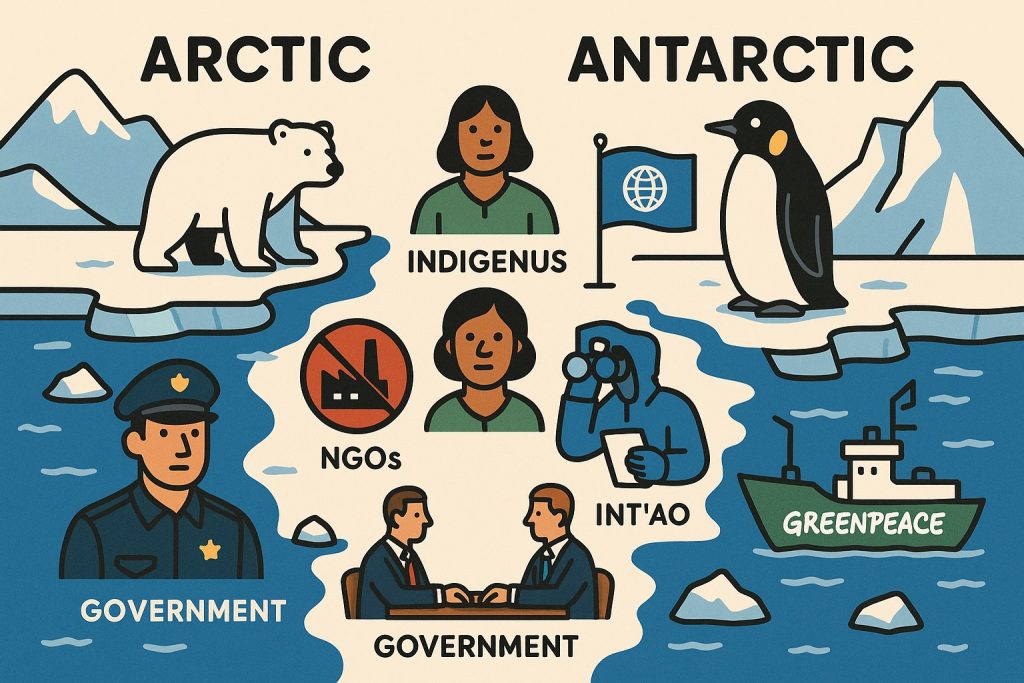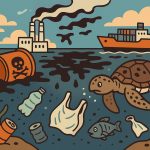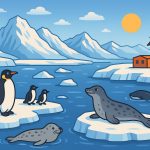The Arctic and Antarctica are two of the most extreme and fragile environments on Earth. These icy regions play critical roles in regulating the planet’s climate, supporting unique ecosystems, and acting as indicators of global environmental health. Despite their remoteness, they are not untouched by human activity. This raises a vital question: Who protects the polar regions, and how is it done?
What’s at Stake?
The Arctic, located around the North Pole, is an ocean surrounded by land. It is home to native peoples, polar bears, seals, and migratory birds. In contrast, Antarctica is a frozen continent at the South Pole, with no permanent population, but hosting seals, penguins, and krill that fuel an entire marine food web.
Both regions are under threat from:
- Climate change (rising temperatures, melting ice)
- Resource exploitation (fishing, mining, oil drilling)
- Pollution (microplastics, shipping traffic)
- Geopolitical interest (military presence and territorial claims)
How Antarctica is Protected
Antarctica is one of the most successfully protected environments on Earth, thanks to the Antarctic Treaty System (ATS), signed in 1959 by 12 nations. Today, over 50 countries are parties to the treaty. The key principles include:
- Demilitarization: No military activities or nuclear testing.
- Scientific cooperation: Open data-sharing and research collaboration.
- Environmental protection: Strict controls on waste, tourism, and fishing.
Further protocols, such as the Protocol on Environmental Protection (1991), banned all mineral mining and designated Antarctica as a “natural reserve devoted to peace and science.”
The Complex Case of the Arctic
Unlike Antarctica, the Arctic does not benefit from a unified international treaty. It is governed by overlapping national jurisdictions and indigenous rights. The main frameworks include:
- Arctic Council: An intergovernmental forum of 8 Arctic nations and indigenous groups, focusing on sustainable development and environmental protection.
- United Nations Convention on the Law of the Sea (UNCLOS): Governs maritime boundaries and seabed claims.
- National laws: Each Arctic country (e.g., Canada, Russia, USA, Norway) has its own environmental policies.
While some areas are protected, large portions of the Arctic remain vulnerable due to the absence of a binding treaty like that of Antarctica.
Who Are the Protectors?
- Governments: Signatory nations enforce rules, establish marine protected areas, and conduct patrols.
- Scientists: Monitor climate data, wildlife health, and human impacts.
- Environmental NGOs: Organizations like Greenpeace, WWF, and Ocean Conservancy lobby for protections and monitor illegal activities.
- Indigenous Peoples: Guardians of traditional knowledge and stewards of the land.
- International Bodies: UN agencies and treaty organizations coordinate research and conservation.
Challenges Ahead
- Melting ice opens new shipping routes and access to untapped resources, increasing exploitation risks.
- Geopolitical tension may weaken international cooperation.
- Climate feedback loops in polar regions accelerate global warming.
Protecting the poles requires global solidarity, enforcement of existing agreements, and possibly new treaties—especially for the Arctic.
Glossary
- Arctic — Polar region around the North Pole, consisting of ocean surrounded by land.
- Antarctica — Southern polar continent covered by ice, with no permanent residents.
- Climate change — Long-term alteration of temperature and weather patterns.
- Antarctic Treaty System (ATS) — International agreement that preserves Antarctica for peaceful and scientific use.
- UNCLOS — UN treaty defining nations’ rights over seas and seabeds.
- Indigenous Peoples — Original inhabitants of the Arctic, such as the Inuit, who depend on the ecosystem.
- Geopolitical — Related to politics, geography, and power between nations.
- Environmental NGOs — Non-governmental organizations working to protect ecosystems and wildlife.


